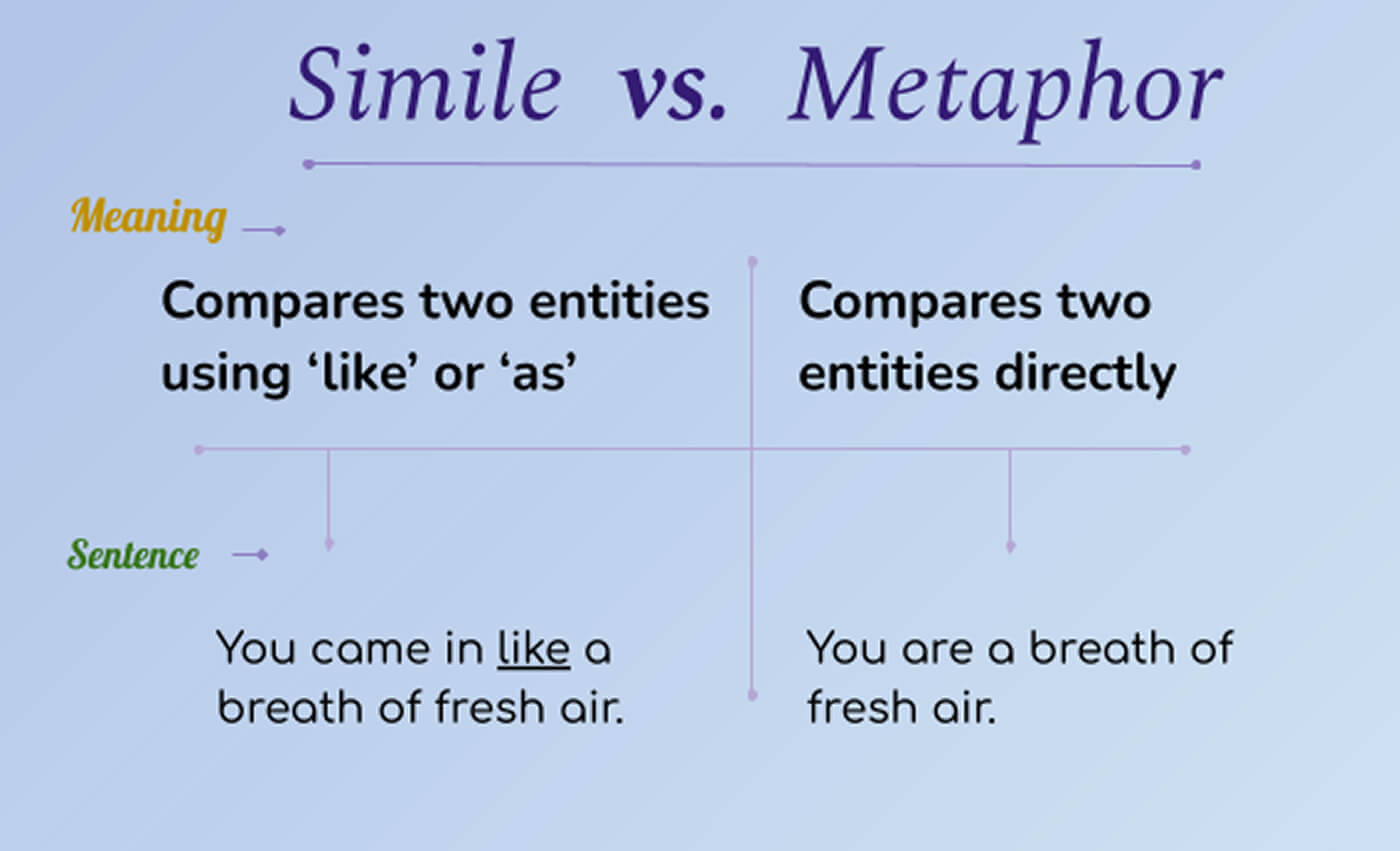The difference between the simile and metaphor is simple but makes them two distinctly different devices that can be used to different effects. Sure, they are both used to compare and contrast, but let’s dive a bit deeper. Why does the difference between simile and metaphor matter?
Simile vs Metaphor Analysis
First, let’s define simile vs metaphor
To understand the differences between simile and metaphor, we have to define each term properly. Then, how these differences affect how writers use them.
SIMILE VS METAPHOR DEFINITION
What is a simile?
A simile is a figure of speech that compares two unlike things, using the words "like" or "as." It creates a direct relationship between two dissimilar objects. One element is being compared to another for emphasis or clarity. Here's an example:
"He was as brave as a lion."
In this sentence, the man is being compared to a lion for his bravery. The words "like" or "as" help us draw a direct parallel between the two.
What is a metaphor?
A metaphor is also a figure of speech that compares two unlike things, but without using "like" or "as." Instead, it directly states that one thing is another. It creates an implicit relationship between the two objects. Here's an example:
"Her eyes were sparkling diamonds."
In this sentence, the woman's eyes are being compared to diamonds, stating that they possess the same qualities. The comparison is not explicitly stated but is implied through the use of metaphor.
Simile and Metaphor Difference
Indirect vs Direct Comparison
When we talk about similes and metaphors, we're really talking about comparisons. But not all comparisons are the same.
Similes, with their "like" or "as", are the masters of indirect comparison.
Picture this: "He roars like a lion". It's a suggestion, an implication.
Metaphors, on the other hand, don't beat around the bush. They're direct comparisons and to-the-point. They state that one thing is another.
Think: "He is a lion." There's no room for ambiguity here, it's an assertive declaration.

Simile and Metaphor Examples
Similes and indirect comparisons can be valuable tools for creating vivid imagery without being too overt. In contrast, metaphors excel at conveying direct and impactful messages. Why is this important? Let’s dive deeper into this key difference.
How are Similes and Metaphors Different in Use?
Suggestions vs Declarations
How do you know what to choose between these two literary devices? Well, it depends.
Despite their subtlety, don't mistake similes for the weaker of the two. Subtly can have a tremendous impact because they are indirect and suggest rather than make a bold claim. This allows and invites room for interpretation as to how things can be alike.
Metaphors hit a comparison head-on. It's a comparison that leaves no room for interpretation. When a metaphor states that one thing is another, it leaves a lasting impression. It doesn't just suggest, it declares, it emphasizes.
For example, take this line: "She sings like an angel." It conveys a sense of admiration and beauty, and it does so without explicitly saying that she *is* an angel. It's a delicate balance between suggestion and assertion.
In contrast, metaphors thrive on their assertiveness. Take the example: "She is an angel." This phrase leaves no room for doubt or interpretation. It makes a bold statement about the woman's character and qualities.
Simile vs Metaphor
Sentence Level vs Entire Work
Similes are often used at the sentence level, providing a brief but impactful comparison. It adds depth and meaning to a specific moment in a text. This occurs on a smaller but much more consistent scale.
In contrast, metaphors can extend beyond a single line or sentence. They can be recurring themes or symbols throughout an entire work, adding layers of meaning and symbolism for readers to uncover.
For example, in the poem "The Love Song of J. Alfred Prufrock" by T. S. Eliot, the speaker says: "My love is like a red, red rose." This simile perfectly captures the intensity and beauty of the speaker's love for his beloved.
On the other hand, metaphors have a broader scope and can be used throughout an entire work to convey a central theme or message.
In George Orwell's classic novel Animal Farm, the pigs use their leadership role to manipulate and control the other animals, representing totalitarianism in society through metaphor.
Similes and metaphors — two powerful tools in the writer's toolkit. Both serve to enrich language, create vivid imagery, and deepen understanding. But remember, they do so in their unique ways.
Up Next
What are Literary Devices?
If you're captivated by the power of similes and metaphors, you might want to explore more tools to enhance your writing — stay tuned for our next article where we break down literary devices.
